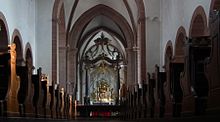St. Peter und Alexander (Aschaffenburg)
The current structure is a cruciform basilica, reflecting a variety of styles including a Romanesque nave from the 12th century and a 15th-century tower.
The church is also notable for its Renaissance painting Beweinung Christi by Matthias Grünewald and the 10th-century Triumphkreuz [de].
His son Otto died from an epidemic in Lucca in 982 but was buried at Aschaffenburg by Archbishop Willigis of Mainz.
[5]: 69–70 [6]: 16–7, 77 It is not clear when exactly construction on the church that replaced the earlier Carolingian structure began, but it was around the middle of the 10th century.
Until this point, the Stift had supplied the priests for the other Aschaffenburg churches, St. Agatha and Unsere liebe Frau.
[7][5]: 72 The church was damaged by Allied bombing in World War II, but most of the works of art survived.
[6]: 16 In 1956, anthropologists from the University of Mainz opened the 13th-century sarcophagi and confirmed that they indeed held the remains of Otto I, Liutgard and her daughter Hildegard.
[7] Access to the church is via a large Baroque staircase from Stiftsplatz with statues of Peter and Alexander at the bottom and a larger-than-life crucifixion group from 1699 at the top.
[6]: 16 The main church building is a cruciform basilica, mostly Romanesque and early Gothic, completed in the 12th century.
Most of these were given away in the 18th century, however, including the Stuppach Madonna, originally made for the Maria Schnee Kappelle in this church (now present as a reproduction).
[8]: 48 Another notable piece of art is a larger-than-life Romanesque crucifix (Triumphkreuz [de]), now on the northern wall of the middle aisle.
[5]: 71 The last Elector of Mainz, Friedrich Karl Joseph von Erthal (died 1802) is buried in the church, in a Neoclassical tomb.

